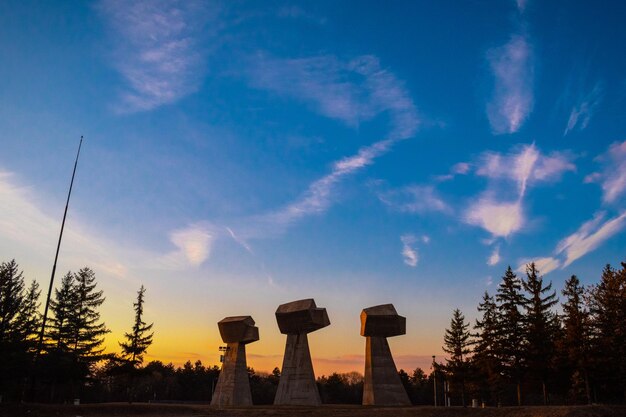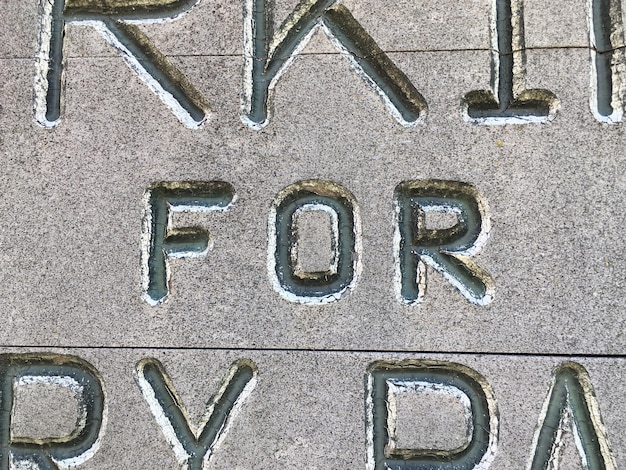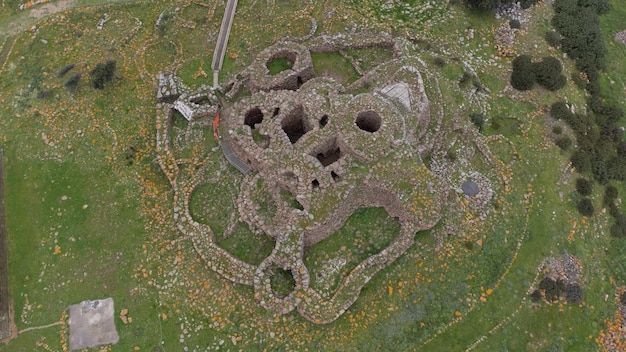Decoding the Georgia Guidestones: A Controversial Message for Humanity

The **Georgia Guidestones: Decoding the Controversial Monument’s Message for Humanity** served as a granite monument erected in 1980, presenting a set of ten guidelines in multiple languages, sparking debates and conspiracy theories about its purpose and origins.
Uncover the mysteries surrounding the **Georgia Guidestones: Decoding the Controversial Monument’s Message for Humanity**, a monument that stirred global debate and sparked numerous conspiracy theories.
The Genesis of the Georgia Guidestones
The Georgia Guidestones emerged in 1980 as a mysterious monument erected in Elberton, Georgia. These monumental granite slabs, inscribed with ten guidelines in eight different languages, quickly became a focal point for both admiration and controversy, sparking a global conversation about their intended message.
The creation of this enigmatic structure was commissioned by a person (or group) using the pseudonym R.C. Christian. The true identity and motivations of the commissioners remain shrouded in secrecy, adding to the overall intrigue surrounding the monument. The Guidestones project was meticulously planned and executed, involving the Elberton Granite Finishing Company and local stonemasons to ensure the monument’s structural integrity and longevity.
The Enigmatic R.C. Christian
The identity of R.C. Christian is one of the most debated aspects of the Georgia Guidestones. Representing the monument’s commissioners, this figure presented a set of specifications and a vision for the stones’ creation. Despite numerous investigations and theories, the real identity of R.C. Christian has never been definitively uncovered, fueling speculation and adding to the monument’s mystique.
Construction and Materials
Built using locally sourced granite, the Georgia Guidestones consist of four large upright stones and a capstone. The stones are arranged in a star-like pattern, aligning with celestial events. The monument’s construction involved precision engineering and craftsmanship to ensure accurate astronomical alignments, contributing to its overall symbolic significance.

The motivations behind the erection of the stones, their secretive commissioner, and the monument’s ultimate purpose all contribute to the ongoing narrative surrounding the **Georgia Guidestones: Decoding the Controversial Monument’s Message for Humanity**.
The Ten Guidelines Inscribed on the Georgia Guidestones
The core of the Georgia Guidestones lies in the ten guidelines inscribed on its granite slabs. These directives, translated into eight languages including English, Spanish, Mandarin Chinese, Russian, Hebrew, Arabic, Hindi, and Swahili, offer a vision for humanity’s future, sparking debate, interpretation, and controversy among diverse global audiences.
The message contained within each directive represents a comprehensive outlook on governance, population control, environmental sustainability, among others. These messages encapsulate a desire for a harmonious balance between humanity and the natural world, advocating for principles of global cooperation and responsible stewardship of resources.
- Maintain humanity under 500,000,000 in perpetual balance with nature.
- Guide reproduction wisely — improving fitness and diversity.
- Unite humanity with a living new language.
- Rule passion — faith — tradition — and all things with tempered reason.
Each guideline is carefully worded to promote a specific vision for the future, intending to serve as guidance for generations to come. As such, the Georgia Guidestones function as a mysterious, ancient, yet modern monument, calling viewers to imagine a world steered by these principles.
While these messages provide a framework open to philosophical analysis, their ambiguous nature has also been the fodder for numerous conspiracy theories. Critics question the motives of R.C. Christian and the implications of such directives on society.
Interpretations and Symbolism
The Georgia Guidestones are replete with symbolism, open to multiple interpretations. From astronomical alignments to the choice of languages, every element contributes to the monument’s intricate web of meaning.
The orientation of the stones, their alignment with the sun and stars, and the overall structure of the monument indicate a design that seeks to connect humanity with the cosmos. The monument’s creators likely aimed to emphasize the importance of astronomical knowledge and our place in the broader universe.
Astronomical Alignments
The Guidestones are precisely aligned with the movements of the sun, marking the summer and winter solstices, as well as the equinoxes. A hole drilled through one of the stones allows observers to locate the North Star, further linking the monument to celestial navigation and observation. These alignments suggest the creators were interested in promoting a reverence for natural cycles and temporal patterns.
Language Selection
The choice of languages is also significant. Featuring English, Spanish, Mandarin Chinese, Russian, Hebrew, Arabic, Hindi, and Swahili, the Guidestones aimed to communicate with a large portion of the world’s population. This selection of languages reflects an effort to present a global vision accessible to people from diverse cultural backgrounds.

The symbolism and the interpretations of the Guidestones continue to inspire debate, encouraging people to think critically about humanity’s purpose and the future of society. Regardless of one’s interpretation, the stones remain a remarkable feat of engineering and speculative thought.
Controversies and Criticisms Surrounding the Monument
The **Georgia Guidestones: Decoding the Controversial Monument’s Message for Humanity** have faced consistent criticisms and stirred controversies since their inception. The monument, due to its cryptic messages and enigmatic commissioner, has been the subject of various conspiracy theories and public disputes.
Critics often view the Guidestones’ guidelines as advocating for a new world order or promoting an elitist agenda. Specifically, the call to maintain humanity under 500 million has been interpreted by some as a justification for mass genocide or eugenics. Others claim the stones foster anti-Christian or anti-American ideologies, leading to acts of vandalism and calls for the monument’s removal.
Despite these contentions, supporters assert that the Guidestones are intended as a set of guiding principles for humanity’s survival in the face of global catastrophes. They view the messages as suggestions for a more sustainable and harmonious future, designed to provoke thought and discussion rather than dictating specific actions. Supporters also underscore that the monument’s purpose is to encourage global cooperation and responsible environmental stewardship.
Consequently, the Georgia Guidestones remain an enduring symbol of both hope and fear, encapsulating diverse perspectives on where humanity should be headed.
Acts of Vandalism and Destruction
Over the years, the Georgia Guidestones have been subject to multiple acts of vandalism, reflecting the intensity of opinions surrounding the monument. In July 2022, the monument suffered a significant blow when explosives were detonated, severely damaging one of the upright stones. Soon after, the remaining structure was demolished by authorities, citing safety concerns.
The act of destruction was celebrated by some, who believed the monument represented malevolent intentions. Conversely, preservationists mourned the loss of a unique and thought-provoking landmark. The incident sparked a renewed debate about free speech, public art, and the balance between preserving history and addressing public grievances.
Immediate Aftermath and Investigation
Following the explosion, law enforcement agencies launched an investigation to identify the perpetrators. Despite some leads, the investigation has yet to yield definitive results, adding another layer of mystery to the Guidestones’ narrative. The incident fueled even greater speculation about the forces opposed to the monument and its message.
Reactions from Different Groups
The destruction elicited a range of reactions, from those who saw it as an act of liberation to those who condemned it as an act of cultural vandalism. The event underscored the deep divisions within society over the Guidestones’ meaning and legacy. Public forums and media outlets became arenas for heated discussions on the monument’s place in contemporary culture.
The vandalism and subsequent demolition of the **Georgia Guidestones: Decoding the Controversial Monument’s Message for Humanity** mark a significant chapter in the monument’s story. Whether seen as an act of iconoclasm or an effort to remove a symbol of divisive ideologies, the event underscores the complex relationship between monuments, public opinion, and the pursuit of meaning.
The Enduring Legacy of the Georgia Guidestones
The Georgia Guidestones, despite their physical destruction, leave behind an enduring legacy filled with mystique and controversy. These granite slabs, once standing tall in rural Georgia, have sparked countless discussions and ignited imaginations around the world. Their impact extends beyond the physical realm, deeply rooted in debates about humanity’s future, governance, and the role of monuments in shaping public thought.
As a source of alternative theories, the Guidestones remain an intriguing landmark in the annals of speculative history. Their messages, though contentious, have inspired critical thought about societal norms, sustainability, and the balance between human progress and environmental stewardship. By challenging conventional wisdom and inviting varied interpretations, the Guidestones fostered an ecosystem of debate that persists even after their demolition.
| Key Point | Brief Description |
|---|---|
| 🤔 Origin | Commissioned anonymously by R.C. Christian in 1980. |
| 📜 Ten Guidelines | Messages inscribed in eight languages offering guidance for humanity. |
| 💥 Destruction | Damaged by explosives in July 2022, leading to demolition. |
FAQ
▼
The Georgia Guidestones were commissioned by an individual, or group, using the pseudonym R.C. Christian. The true identity of this person/group remains unknown, adding to the monument’s mystique.
▼
The ten guidelines covered topics such as population control, global unity, environmental conservation, and reasoned thinking. They were presented as directives for a future age of reason.
▼
The monument sparked controversy because certain directives were misinterpreted. They incited fears about elitism and prompted numerous conspiracy theories surrounding the monument’s purpose.
▼
The Guidestones were aligned astronomically to mark solstices and equinoxes. A hole in one stone even allowed one to see the North Star, emphasizing cosmic connections.
▼
In July 2022, explosives damaged one of the stones. Then, for safety reasons, the remaining structure was deliberately demolished, ending one long and controversial era.
Conclusion
In conclusion, the **Georgia Guidestones: Decoding the Controversial Monument’s Message for Humanity** represented more than just granite and cryptic messages; they symbolized enduring questions about humanity’s path. Though now gone, the debates they spurred are a testament to their lasting cultural impact.